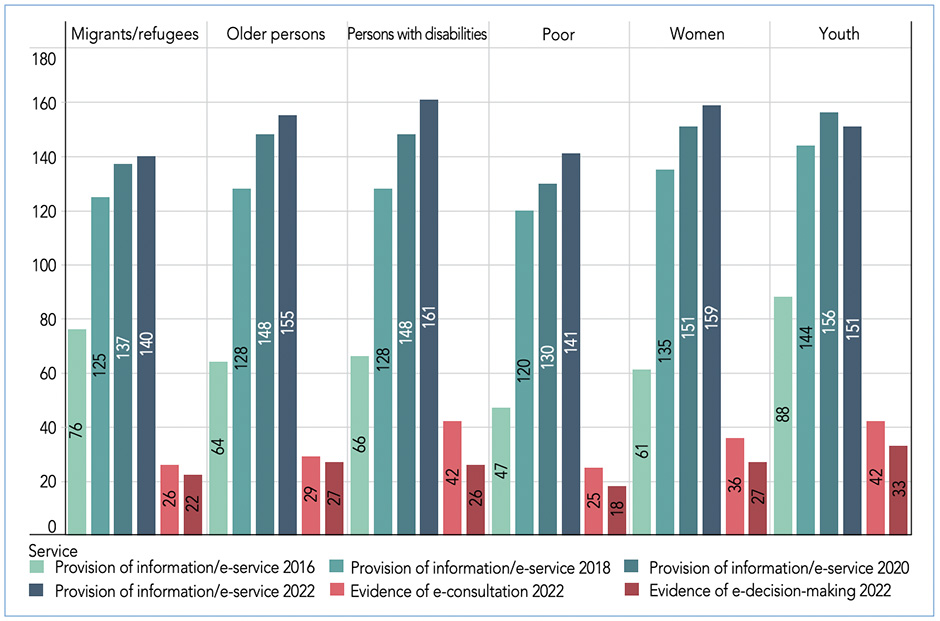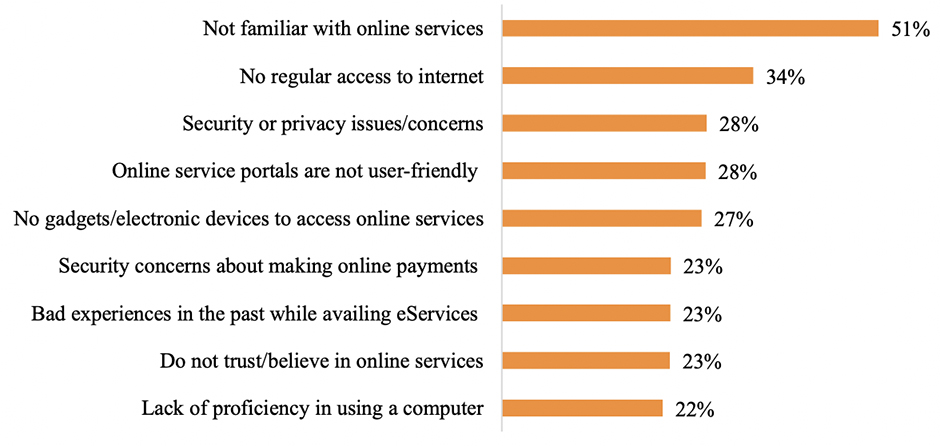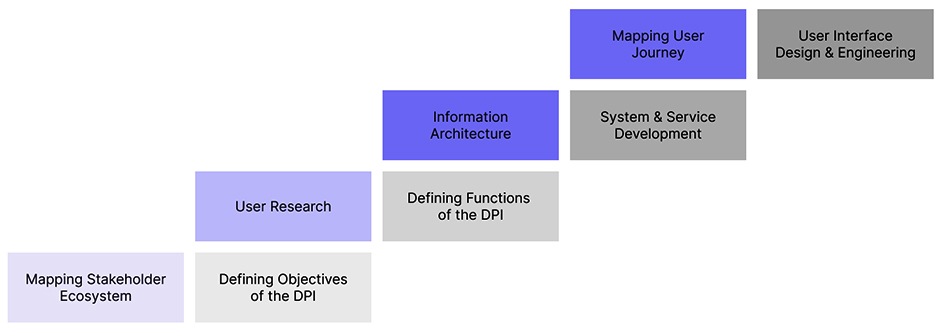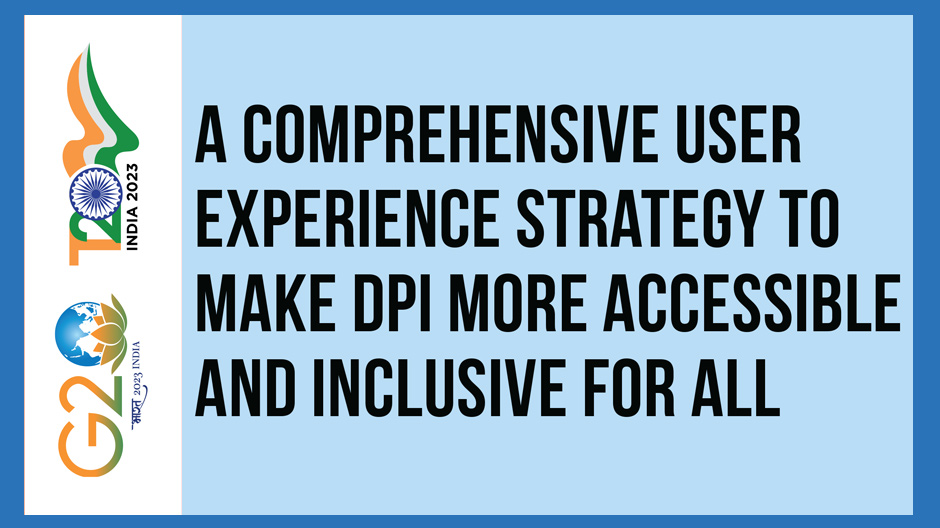TF-2: Our Common Digital Future: Affordable, Accessible and Inclusive Digital Public Infrastructure
Many countries have prioritised online health, education, social protection, and justice services to combat the COVID-19 pandemic. This has meant simplifying various government-citizen digital operations. The World Bank’s ‘Identification for Development’ initiative, for instance, is helping 49 nations deploy digital IDs, thereby increasing the demand for digital public infrastructure (DPI).
The foundational ground of DPI is triadic in structure, with a focus on mediating the flow of people, money, and information in the country. Post-pandemic DPIs focused on bridging demand-supply gaps and minimising needs. As we move forward, we can construct a solid and sustainable infrastructure that prioritises users, inclusivity, usability, accessibility, and global aspirations. We propose a comprehensive user experience plan for the G20 countries to promote user uptake and engagement to establish a shared commitment towards accessible and inclusive digital public infrastructure. The plan consists of the following key points:
- User representation and research: Localising user content, strategy, and behaviours for relatability is important. Additionally, clustering citizens into personas based on circumstances, needs, goals, and behaviours could help DPIs meet their needs better.
- Humanised interaction: Bringing content relatability and user personas together to prioritise user needs.
- Detailed Information Architecture (IA): IA is the standard practice of organising data, user-facing information, and content to ensure easy navigation, access, and understanding.
- Document user experiences: Establishing an open repository of user experiences to help the community improve DPIs and create more inclusive implementations.
- Design councils for DPIs: The UK government created the UK Design Council to improve residents’ lives through design. Similar design councils can advise governments on design and promote design as a basic value creator, enabling happier, healthier, and safer lives for all.
1. The Challenge
Citizens need easy access to public information in the digital era. DPI’s accessibility, inclusivity, digital literacy, and usability limits make information access unequal. A user-centric strategy that considers cultural, geographical, social, behavioural, and economic factors is needed to address this issue.
The primary obstacles faced by DPI in implementing a user-centric strategy can be classified as follows:
Identifying and understanding stakeholders for participatory design while building DPI
The 2030 Agenda for Sustainable Development emphasises the principle of leaving no one behind, which necessitates identifying user and stakeholder needs. It is necessary to cluster citizens according to their context, needs, goals, and behaviours instead of considering them one homogenous group.
According to the UN E-Government Survey 2022,[1]The availability of e-participation platforms does not always reflect a broader or deeper level of participation. In many countries, e-participation mechanisms continue to be underutilised. As depicted in the figure below, very few countries show evidence of online consultations involving vulnerable groups, and even fewer demonstrate that public input is incorporated in policy decisions on issues pertaining to vulnerable groups.
Figure 1: Provision of e-information, e-services, e-consultation mechanisms, and e-decision-making opportunities for vulnerable groups

Source: UN E-Government Survey 2022[2]
Sensitisation to good user experience (UX) in civic engagements
Currently, the building of DPIs is predominantly unidirectional, with a focus on generating supply rather than addressing need and demand. The current implementation of DPIs is based on the government’s interpretation of how citizens consume information, rather than an understanding of how citizens locate and consume information in practice. Such barriers in the communication between governments and citizens result in usability issues, necessitating improved user experiences and fostering a sense of interconnectedness.
According to an article by the World Bank[3]civil servants are at the receiving end of bad UX as the software design created for simple and menial duties are so poorly thought out that users require hours of training to operate it. In the worst-case scenario, which is regrettably the most common, this results in civil servants refusing to adopt new software despite the availability of training. Behind the oft-heard phrases “resistance to change” and “poor ownership” is frequently just poor UX design, a problem that cannot be solved with decrees and money alone.
The department of administrative reforms and public grievances published a report in India in 2021 titled “National e-Governance Service Delivery Assessment 2021” that encouraged all levels of departments and ministries—states, union territory, and at the Centre—to improve their digital service delivery across the country in every socio-economic sphere.[4] The survey shared below collected feedback from a diverse set of stakeholders and end-users across different regions in India pertaining to services across different sectors.
Figure 2: Top reasons for not availing e-Services National e-Governance Service Delivery Assessment 2021

Source: National eGovernance Service Delivery Assessment 2021
According to the survey, 28 percent of participants did not find online service portals user-friendly, and 23 percent had bad experiences with e-services. It was further stated that 22 percent of participants were not proficient in using a computer. DPIs should be built with substantial consideration of these nuances. Currently, the digital applications being built do not expose citizens to good UX practices and citizens assume that it is the best digital experience that can be delivered to them.Hence, they compromise and settle for DPI that doesn’t meet their needs. and requires more investment in terms of time, money, and effort.
Overall, this report suggests that we need to cater to these critical aspects of user experience by considering the digital literacy and privacy of users. This would require considerable research and testing. Bad UX risks inadequate information consumption, which disempowers users and disincentives adoption.
Information overload
In this age of information, it is increasingly becoming important for citizens to be informed while making decisions that affect governance. Information presentation greatly influences end users’ decisions to use a digital service. Citizens are often unaware of the risks associated with digital services, especially concerns around data privacy and consent.
To be able to make informed decisions, citizens must be able to access and discover information easily. Ignorance should not be mistaken for a lack of concern. Rather, it demonstrates a fundamental barrier to easy information access. With sufficient education and emphasis on information literacy (skills and knowledge that enable citizens to recognise, find, evaluate, filter, and use the necessary information), any citizen would be able to make active efforts to understand their rights, responsibilities, and risks in the use of digital services.
Additionally, considering the volume of information that users are exposed to each day, it is important to prioritise relevance and reliability so that users don’t end up missing crucial details. Users are not always aware of how to locate specific information, and this can result in frustration and a lack of service adoption.
Inconsistencies in digital workflows
DPIs have the potential to foster trust and encourage the adoption of new technologies by diverse user groups. Additionally, it serves as a brand identity for government services. Establishing trust in the context of DPI has multiple facets, including data security and privacy, institutional accountability and grievance redressal, proactive communication, and change management.
Different DPIs serve different purposes, but users’ digital interactions must be governed by a standardised framework or workflows. DPIs must prioritise user experience and user journeys on their respective platforms. There is insufficient understanding of how design consistency can facilitate convenience when interacting with digital interfaces. Visual elements such as icons and layouts, navigation elements, integrations across related digital platforms, information architecture, error prevention strategies, etc., are all examples of design consistency. Frequently, these design elements are disregarded until the very end, having little role to play during platform development. As a result, these platforms are not user-friendly and intuitive.
Web accessibility parameters are insufficient because they correspond more with the technical accessibility of a platform than with its usability factors. Accessibility, instead, should be judged on the basis of digital literacy, interaction, navigation, language, basic familiarity, and information literacy in addition to contrast ratios and legibility issues.
2. The G20’s Role
In a group of 20 nations from across the globe with different cultures, economies, and societal structures, there are many possibilities to learn from one another. For instance, very few of the G20 countries have already set up design councils that help improve the user experience of DPIs.
The GOLD Design System by the Australian government provides User Interface (UI) components and templates that deliver uniform UX and meet the Digital Service Standards. [5]The US Web Design System also features UX patterns, components, and guidelines. The website also provides utilities to make front-end development easier.[6] Additionally, the Design Council in the UK has established itself as a strategic advisor to the UK government.[7]
The G20 can learn from its experience of creating open source UX patterns and replicate proven and tested practices.
3. Recommendations to the G20
Undertake stakeholder mappings
Every DPI is built with an objective to solve the requirements of a certain set of stakeholders. Hence, stakeholder mapping becomes essential for identifying and defining individuals and groups, their requirements, and their stake in the success or failure of the project.
This activity of stakeholder mapping would entail:
- Identifying and mapping the ecosystem of stakeholders who would be affected by the development of a DPI and understanding their interest in For example, a citizen’s primary interest would be to access the online services of the government, while the private sector’s primary interest would be to strengthen and expand their market through informed decision-making.
- Analysing stakeholder groups and clustering them based on their patterns of behaviour and needs from the DPI.
- Defining stakeholders’ use cases and patterns with respect to digital literacy and adaptability. This would also involve defining personas within the stakeholder groups to improve digital services and ensure inclusivity. Organisations such as D91 in India[8] and the Behavioural Insights Team[9] in the UK leverage user personas to understand user behaviours and improve interventions.
These stakeholder maps, analyses, and personas should be anonymized and summarised into reports to be put out in the open to reassure stakeholders and to allow other public entities to reuse them for building other platforms or tools.
Humanised service design approach to DPI
By adopting the service design approach, DPIs can be built with the users’ needs at the centre, thus driving better UX. Governments can adopt ‘inclusion-first’ or ‘people-first’ strategies to counter the shortfalls created by the current ‘digital-first’ strategies that likely focus on just the functional aspects of the service. To ensure greater integration of microservices, it is essential to focus on the user experience of any DPI’s services as a whole, rather than just on digital public goods such as apps, websites, and tools. One of the most important aspects of humanising DPIs would be to account for diversity, not only in terms of inclusivity and accessibility, but also in the composition of the team. It is essential to have a diverse and multidisciplinary team to capitalise on their unique perspectives.
This framework of service design suggests that processes can be both parallel and sequential in nature and can also inform the traditional development process. This design procedure guarantees that users are represented, and their requirements are validated at every stage, developing a user centric DPI service in a holistic manner.
Figure 3: Suggestive Service Design Framework for DPI implementation

Source: Authors’ own
Value creation through participatory design
According to the UN E-Government Survey 2022[10], it is important to have a strong, user-focused e-government ecosystem to make sure that all users, including those in vulnerable groups, can use e-government services in a meaningful way and are happy with them. Governments need to get information from and about users so they can figure out what each group of people needs and how happy they are with the service.
The government can create a positive user experience through multiple engagement methodologies:
- Services can be made more user-centric by introducing digital clinics for the elderly, for people with minimal digital literacy, and those that lack access to digital technology.
- Encourage people to take part in forums to give feedback on how to improve public services. For example, the city of Cologne, Germany, used participatory budgeting where residents helped decide how to allocate a portion of the municipal budget.[11]
- User testing workshops can be conducted where users from diverse groups participate. This needs to be a mandated practice in the process of building the DPI.
- Its important to approach delivery holistically by contextualising the nuances of the local community—including gender, culture, religion, and local power dynamics—which would be possible only through more effective research and engagement.
- Create an open repository of user experiences that can help the community improve existing DPIs and create more inclusive interventions in the future.
Strategic design body to advocate for user-friendly DPIs
- Following in the footsteps of a few G20 countries, other member countries can make efforts to leverage a national design council as an advisory body guiding public organisations creating DPIs.
- Efforts can be made to set up a community of professionals, bureaucrats, designers, social researchers, behavioural scientists, and technocrats, who understand the value of design and can advocate for users.
- Public entities can also consider inviting public-private partnerships in order to delegate work that ordinarily requires the expertise of designers and researchers.
Limitations
While the purpose of this paper is to provide recommendations for designing a better UX for DPIs and DPGs, more research is required to address the challenges posed to DPI adoption by limited access to digital connectivity. The recommendations emphasise how the experiences of users with access to devices that enable them to utilise digital services can be enhanced. However, future research may also target ways to enhance the experiences of those who lack access to mobile phones or the internet. How can we facilitate their access to digital services?
Attribution: Nupura Gawde, Gaurav Godhwani, and Kiran Sabnis, “A Comprehensive User Experience Strategy to Make DPI More Accessible and Inclusive for All,” T20 Policy Brief, July 2023.
Appendix
Expert Advisory panel details:
As a part of the writing process, we interviewed several experts from a few G20 countries, including India. The objective of these consultations was to understand their perspectives on the subject.
- Uday Athawankar (ex-Director, IDC IITB)
- Chaitanya Nadkarni (Advisor and mentor)
- Sonakshi Chaudhary (Strategic Partnerships & Comms at The Quantum Hub & YLAC)
- Isha Suri (Senior Researcher, Centre for Internet and Society)
- Matilda Agace (Senior Policy and Advocacy Manager at the Design Council, UK)
- Ruth Schmidt (Associate Professor of Behavioural Design at the Institute of Design, Illinois Institute of Technology, Chicago)
Endnotes
[1] United Nations, “E-Government Survey 2022: The Future of Digital Government,” New York, UN, 2022.
[2] “E-Government Survey 2022”
[3] Tiago Carneiro Peixoto, Kai Kaiser, and Huong Thi Lan Tran, “Digital Government: Minding the Empathy Gap,” January 30, 2020, World Bank Blogs.
[4] Department of Administrative Reforms and Public Grievances, Government of India, “National E- Governance Service Delivery Assessment 2021”.
[5] “Home,” GOLD Design System.
[6] “Homepage,” U.S. Web Design System (USWDS).
[7] “Homepage,” The Design Council.
[9] “Homepage,” The Behavioural Insights Team.
[10] “E-Government Survey 2022”
[11] Diana Farrell and Andrew Goodman, “Government by Design: Four Principles for a Better Public Sector,” McKinsey & Company, December 1, 2013.





